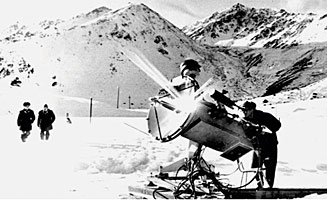Millimeter waves provide unique possibilities for remote sounding of the environment due to the fact that this wavelength band contains the lines of the rotational spectrum of main atmospheric gas constituents and a great number of pollutions, specifically, those of the anthropogenic origin. Additionally, the characteristic sizes of the inhomogeneity of natural covers and impurities on them are comparable with the wavelengths.
IAP researchers A. G. Kislyakov, Yu. A. Dryagin, L. I. Fedoseev, et al. designed special equipment operated in the short-wave part of the millimeter-wave band, developed methods of sounding and evaluating sounding efficiency under different conditions, and created algorithms for classification and interpretation of measurement data. Special attention has been given to the development of multi-frequency, polarization and combined passive-active sounding, which in many cases allow one to avoid necessity of prior data about the object that are required, as a rule, for single-frequency sounding. Radiophysical methods of studying spatio-temporal variations of ozone and other minor gas constituents of the atmosphere have been developed. Their main advantages are operativeness and the possibility of twenty-four-hour ground-based monitoring under nearly any weather conditions without rain or snow.
A unique complex, which consists of high-sensitivity radiometers covering the wavelength interval from 8 to 0.8 mm, pulseradar, and scatterometers in the 8-, 3-, and 2-mm ranges, as well as onboard (aircraft- and ship-borne) radiometers and scatterometers, has been developed and manufactured (L. V. Lubjako, Yu. Yu Kulikov, et al). The complex was used to study statistical characteristics of the optical depth of the atmosphere, the contrast-forming temperature difference, radiation of and scattering from the underlying surface and objects in all millimeter-wave transparency windows for different climate zones from Heiss island (80,7º N) to Ashgabat (37,6º N), as well as at the Antarctic observatory at Mirny and in the highlands (Zailiyskiy Alatau).
A fast method for prediction of the optical depth of the atmosphere and radiothermal contrasts in various physico-geographical zones basing on one parameter, specifically, the annual precipitation, has been developed.
New multi-frequency and polarization methods of remote passive microwave sounding based of scattering of frequency-dependent and nonisotropic atmospheric radiation by the Earth's surface and solid-particle clouds have been developed and realized in airborne measurements. These techniques allow simultaneous measurements of the emissivity and thermodynamical temperature of the effectively radiating terrestrial layer and detection of suspended particles in an absorbing atmosphere including pyroclastic volcanic emission and sand or dust storms. Among other things, it allows one to detect thermal pollution of surfaces (A. A. Shvetsov). A method of detection of metal objects has also been developed. A portable three-frequency millimeter-wave polarimeter for remote studies of the underlying surface, which uses the radiation of the Earth's atmosphere in the molecular-oxygen line with the central wavelength 2.5 mm has been developed, manufactured, and tested successfully. A completely solid-state device based on Russian technological developments allows one to obtain information both about the albedo of the Earth's covers and about the thermodynamical temperature of its effectively radiating layer.
 |
Adjustment of the submillimeter radio telescope (Zailiyskiy Alatau, altitude 2800 m above sea level); spectral lines of the stratospheric ozone in the frequency range from
214 to 244 GHz were measured for the first time in the world with this telescope
|
A mobile microwave ozonometer with a digital spectrum analyzer (the 110.4—111.2 GHz range) for studies of the ozone layer at altitudes from 15 to 70 km has been developed, manufactured, and tested successfully. For the devices with an uncooled receiving unit, the mobile ozonometer has world-class parameters, while being much smaller. The small size and light weight made this device a unique tool for field measurements (A. A. Krasil'nikov). A statistical, based on the Bayesian approach algorithm for retrieval of the vertical distribution of ozone density from the data of ground-based radiometric sounding in the millimeter-wave band has been developed and is used successfully (A. M. Feigin, D. N. Mukhin, et al.).
|
|
Example of vertical distribution of the ozone density over Nizhny Novgorod, which was retrieved from the April 10, 2010 microwave sounding data, in comparison with the satellite measurement data (Aura MLS). The red profile shows the most probable distribution, the black lines show the boundaries of the 65% confidential interval, and the blue profile is the result of the Aura MLS measurements.
|
Receiver unit
of the portable ozonometer
|
For the first time, a prototype of the spectroradiometric complex for ground-based passive thermal sounding of the middle atmosphere has been developed, manufactured and successfully tested. The complex includes a unique system of internal calibration and a digital spectrum analyzer, allows retrieval of the vertical distribution of the temperature in the stratosphere and upper troposphere from measured spectra of the self-radiation of the atmosphere near the edge of the 6-mm absorption band of molecular oxygen (the 52.4—53.2 GHz frequency range). A statistical Bayesian algorithm of retrieval of the vertical distribution of the temperature in the middle atmosphere from the data of ground-based radiometric sounding in the millimeter wavelength range has been developed and is used successfully (A. M. Feigin, A. A. Shvetsov, L. I. Fedoseev,
D. A. Karashtin, D. N. Mukhin, et al.).
|
|
|
Spatio-temporal evolution of ozone density (in ppmv) over Nizhny Novgorod, which was measured with the mobile ozonometer in January 2012 and retrieved by using the Bayesian approach to solving of ill-posed inverse problems
|
Spatio-temporal evolution of the temperature (Kelvin degrees) in the middle atmosphere over Nizhny Novgorod during a sudden stratospheric warming-up in January 2012. Top: result of retrieval from the microwave remote sounding data; bottom: data provided by instrumental MLS Aura temperature measurements
|





